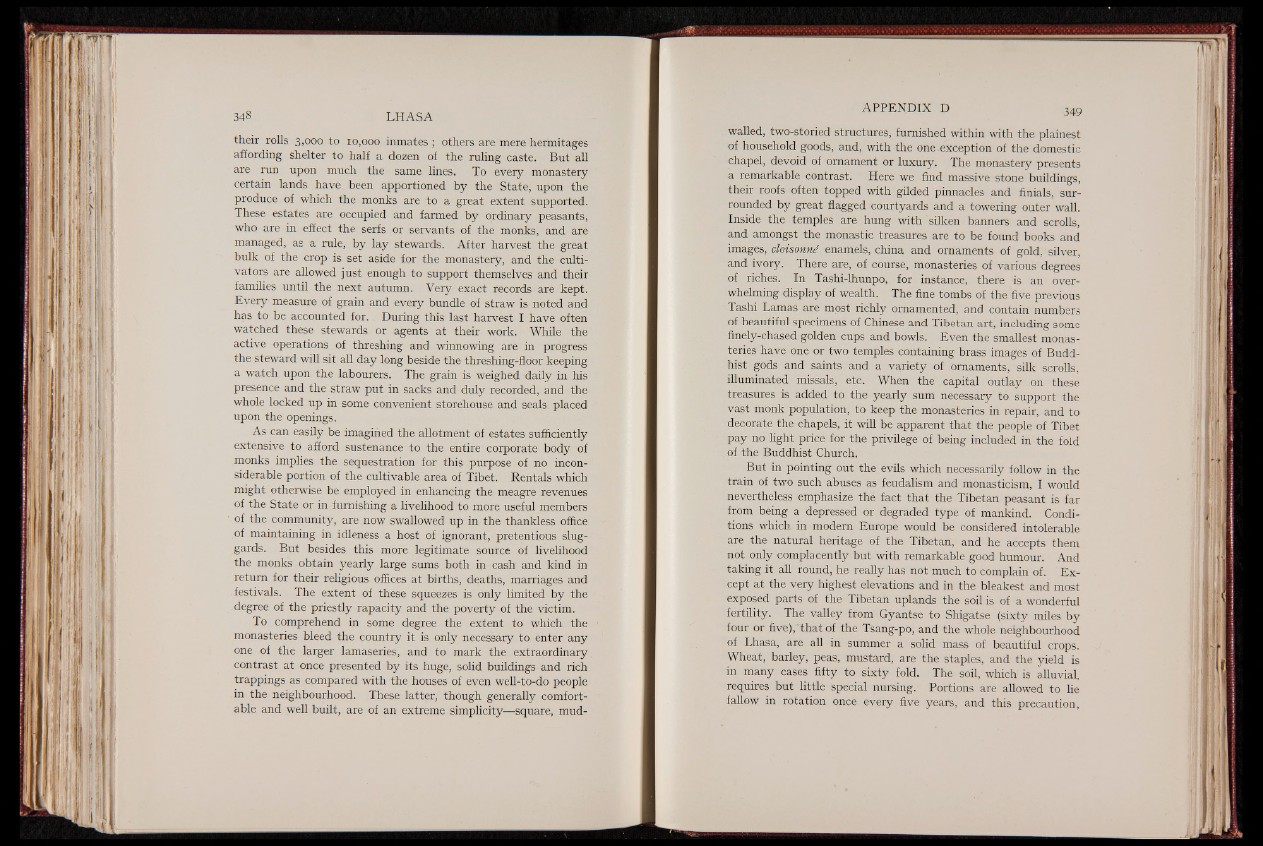
their rolls 3>00° to 10,000 inmates ; others are mere hermitages
affording shelter to half a dozen of the ruling caste. But all
are run upon much the same lines. To every monastery
certain lands have been apportioned by the State, upon the
produce of which the monks are to a great extent supported.
These estates are occupied and farmed by ordinary peasants,
who are in effect the serfs or servants of the monks, and are
managed, as a rule, by lay stewards. After harvest the great
bulk of the crop is set aside for the monastery, and the cultivators
are allowed just enough to support themselves and their
families until the next autumn. Very exact records are kept.
Every measure of grain and every bundle of straw is noted and
has to be accounted for. During this last harvest I have often
watched these stewards or agents at their work. While the
active operations of threshing and winnowing are in progress
the steward will sit all day long beside the threshing-floor keeping
a watch upon the labourers. The grain is weighed daily in his
presence and the straw put in sacks and duly recorded, and the
whole locked up in some convenient storehouse and seals placed
upon the openings.
As can easily be imagined the allotment of estates sufficiently
extensive to afford sustenance to the entire corporate body of
monks implies the sequestration for this purpose of no inconsiderable
portion of the cultivable area of Tibet. Rentals which
might otherwise be employed in enhancing the meagre revenues
of the State or in furnishing a livelihood to more useful members
of the community, are now swallowed up in the thankless office
of maintaining in idleness a host of ignorant, pretentious sluggards.
But besides this more legitimate source of livelihood
the monks obtain yearly large sums both in cash and kind in
return for their religious offices at births, deaths, marriages and
festivals. The extent of these squeezes is only limited by the
degree of the priestly rapacity and the poverty of the victim.
To comprehend in some degree the extent to which the
monasteries bleed the country it is only necessary to enter any
one of the larger lamaseries, and to mark the extraordinary
contrast at once presented by its huge, solid buildings and rich
trappings as compared with the houses of even well-to-do people
in the neighbourhood. These latter, though generally comfortable
and well built, are of an extreme simplicity— square, mudwalled,
two-storied structures, furnished within with the plainest
of household goods, and, with the one exception of the domestic
chapel, devoid of ornament or luxury. The monastery presents
a remarkable contrast. Here we find massive stone buildings,
their roofs often topped with gilded pinnacles and finials, surrounded
by great flagged courtyards and a towering outer wall.
Inside the temples are hung with silken banners and scrolls,
and amongst the monastic treasures are to be found books and
images, cloisonné enamels, china and ornaments of gold, silver,
and ivory. There are, of course, monasteries of various degrees
of riches. In Tashi-lhunpo, for instance, there is an overwhelming
display of wealth. The fine tombs of the five previous
Tashi Lamas are most richly ornamented, and contain numbers
of beautiful specimens of Chinese and Tibetan art, including some
finely-chased golden cups and bowls. Even the smallest monasteries
have one or two temples containing brass images of Buddhist
gods and saints and a variety of ornaments, silk scrolls,
illuminated missals, etc. When the capital outlay on these
treasures is added to the yearly sum necessary to support the
vast monk population, to keep the monasteries in repair, and to
decorate the chapels, it will be apparent that the people of Tibet
pay no light price for the privilege of being included in the fold
of the Buddhist Church.
But in pointing out the evils which necessarily follow in the
train of two such abuses as feudalism and monasticism, I would
nevertheless emphasize thé fact that the Tibetan peasant is far
from being a depressed or degraded type of mankind. Conditions
which in modem Europe would be considered intolerable
are the natural heritage of the Tibetan, and he accepts them
not only complacently but with remarkable good humour. And
taking it all round, he really has not much to complain of. Except
at the very highest elevations and in the bleakest and most
exposed parts of the Tibetan uplands the soil is of a wonderful
fertility. The valley from Gyantse to Shigatse (sixty miles by
four or five),‘that of the Tsang-po, and the whole neighbourhood
of Lhasa, are aft in summer a solid mass of beautiful crops.
Wheat, barley, peas, mustard, are the staples, and the yield is
in many cases fifty to sixty fold. The soil, which is alluvial,
requires but little special nursing. Portions are allowed to lie
fallow in rotation once every five years, and this precaution,